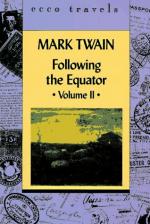|
This section contains 429 words (approx. 2 pages at 400 words per page) |

|
Following the Equator: A Journey Around the World Summary & Study Guide Description
Following the Equator: A Journey Around the World Summary & Study Guide includes comprehensive information and analysis to help you understand the book. This study guide contains the following sections:
This detailed literature summary also contains Topics for Discussion and a Free Quiz on Following the Equator: A Journey Around the World by Mark Twain.
Following the Equator, A Journey Around the World by Mark Twain, describes the author's experience as he travels around the world. The author, whose real name is Samuel Clemens, is accompanied by his wife and daughter on the thirteen-month trip. Their travels occur in the late eighteen hundreds and they traveled by various means of transportation.
Beginning in Paris, where the family is living at the time, they begin by sailing to New York, crossing the American continent, and boarding a ship in Victoria, British Columbia. This is where the story really begins, since Twain has little to say about their experiences on the North American continent. The thirteen-month journey takes them to Hawaii, the Fijis, Australia, New Zealand, Ceylon, Mauritius, Mozambique, and South Africa before they sail to England. The return journey to England takes two weeks.
Twain has a variety of experiences as he travels, just as most people do. He describes these experiences in his own rich way with his own brand of wit. He relates the experiences of the various accommodations on ship and shore, complaining about the bedding on the ships and the noise in the hotel halls in India. There are the servants that are constantly in and out of their quarters, the experience of riding in a jinricksha, trains in India and handcarts in the Himalayas. He describes his experiences at the betrothal party of an Indian girl, riding an elephant for the first time, and visiting Molokai, the leper colony in Hawaii. There was shark fishing in Australia and tiger hunting in India, plus diamond mining in South Africa. Like all travelers, Twain enjoyed these experiences.
In addition to relating his experiences as a traveler, Twain presents various facts about the history and culture of each of the places he visits. He presents economic and demographic data about the countries and often makes comparisons between the places he visits and America and England. He also relates a variety of other stories about places in the world he has visited as the places along the equator are associated with other experiences. He also examines the mistreatment of various groups of people in these countries.
There are charts and illustrations throughout the book showing places, things and people from the various places and experiences that the Twains' had. These allow the reader to associate a picture with the things and places that Twain is describing. The reader will enjoy reading this book. It is extremely fast reading with only the numerous illustrations and charts to slow the reader down.
Read more from the Study Guide
|
This section contains 429 words (approx. 2 pages at 400 words per page) |

|



